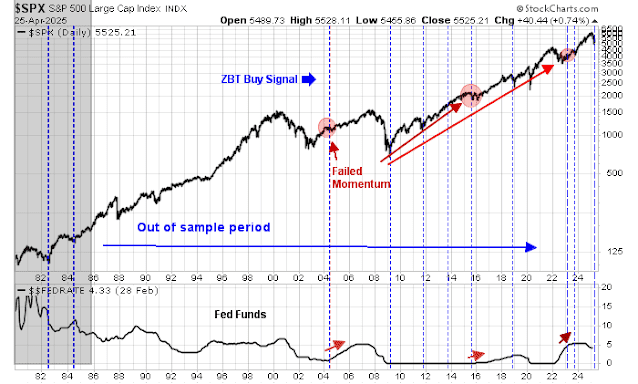Rare Signal Flashes Bullish: Is the Tariff Tantrum Over? US Mining Boom Incoming?
Manage episode 479914715 series 3586928
I spoke about gold this week to ABC Australia. This little interview may be of some interest. Here it is.
Meanwhile …
It’s as though the whole tariff thing never happened, the way stock markets are rallying. I think it’s seven green days in a row now.
Everybody is getting very excited about a rare technical signal we got last Thursday - - there have only been 16 of them since the S&P500 was created in 1957, including the latest on April 24, 2025. But this signal has a 100% reliability record, and has been followed by average 6-month returns of 15% and a 12-month returns of 23%.
That’s a pretty stellar record.
So I just wanted to offer my 2p.
The indicator - the Zweig Breadth Thrust Indicator (ZBT) - was first observed in the 1986 Martin Zweig book, Winning on Wall Street (which I confess to not having read). It occurs when a market swings from an oversold to an overbought reading within 10 trading days.
Eight of them have occurred since the book was published: in 2004, in 2009 (shortly after the March lows at 666), in 2011 after the taper tantrum, in 2013, 2015, 2018 and in 2023 twice. Now we have one coming off the “tariff tantrum”, as I’ve just dubbed it.
However, before you go out and gamble your entire life savings, note that back in 2015 technical analyst Tom McClellan published a detailed study of ZBT signals, which went back much further than the 1957 formation of the S&P500 - all the way to 1928.
During the bear market of the 1930s Great Depression, there were multiple occurrences of the signal - 14 of them - and it was horribly unreliable: 10 led to losses or negligible gains, 2 preceded strong rallies, and 2 were flat. It was useless, in other words.
So, in short, it’s been good since 1957, but was rubbish before. A bit like stereos.
There are plenty of reasons to remain cautious. The high levels of volatility we are witnessing are consistent with a bear market not a bull market. There are also high levels of uncertainty: what is actually going to happen with tariffs? Nobody quite knows. I’m not sure even the President.
Plus we are going into May, usually a weak time of year for the stock market.
And it may be that the consequences of Trump’s tariff talk have not yet been felt in the US on the ground. One argument is that there has been a huge drop off in container ships leaving China. A container would typically take 30 days to reach LA, and another 10-20 days to get to the major cities - Houston, Chicago, New York et al. So the drop-off in container ships leaving China after Liberation Day won’t be felt until mid-May. If there is a pick up in shipments, that wouldn’t be felt till another month after that. Some are saying supply shortages are coming to the US. Have a read of this and see what you think. Markets usually price this kind of stuff in, but you never know.
Cui bono?
Among the sectors that should benefit from Trump’s America first policies are US domestic mining and manufacturing. Here the regulatory environment is changing fast. Trump signed an executive order on March 20 with the aim of accelerating production of critical minerals. Federal agencies have actually been mandated to look to the US for priority metals - copper, gold, nickel, uranium and so - when they previously looked abroad. We are already seeing faster permitting. I hear that formerly dormant projects are seeing activity for the first time in years. Emails are being answered promptly, applications are being processed, even in states like California.
This new environment is positive for oil and gas producers, miners, explorers and developers in the US. The problem is that commodity prices have dropped off a cliff. There’s always a catch.
Even so, one company that should benefit from this new macro environment is this potential multi-bagger.
On which, note I wanted to give you a related heads up.
19 episodes






